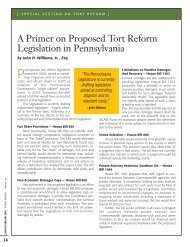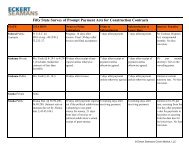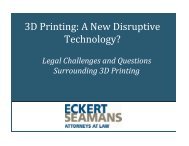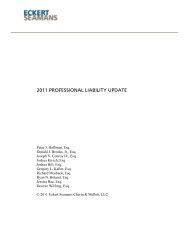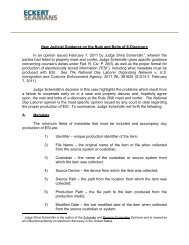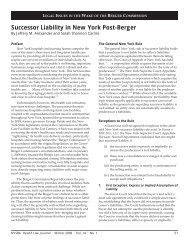Under Pennsylvania law, the Court noted that the Plaintiff has the burden of proof in amedical malpractice claim and must establish that there was: “(1) a duty owed by the physicianto the patient (2) a breach of duty from the physician to the patient (3) that the breach of dutywas the proximate cause of, or a substantial factor in, bringing about the harm suffered by thepatient, and (4) damages suffered by the patient that were a direct result of that harm.” Hankey,2009 WL 2043392, at *4 (quoting Mitzelfelt v. Kamrin, 526 Pa. 54, 584 A.2d 888, 891 (Pa.1990)). The Court also determined that in cases where a patient is likely to suffer harm,regardless of the quality of medical treatment, the proximate cause prong of the test is relaxedand it becomes the realm of the jury “to balance probabilities and decide whether defendant’snegligence was a substantial factor in bringing about the harm.” Id. (quoting Hamil v. Bashline,481 Pa. 256, 392 A.2d 1280, 1286 (Pa. 1978)).In their motions for summary judgment, all the defendants alleged that the Plaintiff couldnot establish that their actions were the proximate cause of the Plaintiff’s injury. However, thePlaintiff put forth expert testimony for each claim stating that each doctor or facility had notadhered to the required standard of care. The Court noted that the substance of all the testimonywould be weighed at trial, but for the purposes of summary judgment there remained a dispute asto the material facts, which warranted denial of the motions for summary judgment.Dr. Baker also sought summary judgment on Plaintiff’s § 1983 claim for violation of theEighth Amendment’s prohibition of cruel and unusual punishment. Particularly, Plaintiff allegedthat Dr. Baker, as a prison official, breached his “obligation to provide medical care for thosewhom [he is] punishing by incarceration.” 2009 WL 2043392, at *9 (quoting Estelle v. Gamble,429 U.S. 97, 104, 97 S.Ct. 285, 50 L.Ed.2d 251 (1976). The Plaintiff had the burden of proof toshow that “Dr. Baker acted with deliberate indifference to Rorhbaugh’s serious medical needs.”Id.Dr. Baker argued that he did follow-up with Rorhbaugh after the surgery and tried torefer him to an oncologist, but that Rorhbaugh insisted on waiting until he was released to seekmedical help. Dr. Baker testified that he then checked with the prison officials to determineRorhbaugh’s release date, which he verified was within 2-8 weeks and met once more with himto ensure that Rorhbaugh knew the severity of the situation and that follow-up care wasnecessary. Plaintiff tried to counter that because Dr. Baker did not order a consultation with anoncologist and because Dr. Baker referred Rorhbaugh to a general surgeon for the excision andnot an oncologist, Dr. Baker displayed deliberate indifference. The Court agreed with Dr. Bakerthat a dispute between preferred choices of treatment does not rise to the level of deliberateindifference and therefore, the § 1983 claims against Dr. Baker could not stand.The Court then discussed Dr. Esper’s request that it “remand or transfer” all state lawclaims remaining after any § 1983 claims had been dismissed. It noted that it would interpretthis request as a request to decline supplementary jurisdiction as the case had originated infederal court, and had not been removed from state court. The Court acknowledged thatexercising supplementary jurisdiction was a matter of discretion, which should be weighedagainst several factors, including judicial economy, convenience and fairness to parties. Becausethe case had been in federal court for numerous years, a date for trial had been set and the statute46
of limitations had run on the Plaintiff’s state law claims, the Court determined that the factorsweighed in favor of retaining supplementary jurisdiction.In Carrozza v. Greenbaum, 866 A.2d 369 (Pa. Super. Ct. 2004), affirmed, 916 A.2d 553(Pa. 2007), a case in which Plaintiff alleged the Defendants failed to timely diagnose her breastcancer, the Superior Court held that testimony offered by Plaintiff’s experts regarding bothstandard of care and causation was sufficient to meet the burden of proof and that there weresufficient facts for the jury to have found in favor of the Plaintiff. Consequently, the trial courthad not erred in denying Defendants’ motion for judgment notwithstanding the verdict.In reaching its holding, the court noted that Plaintiff was not required to establish that theDefendant’s negligence was the actual “but for” cause of her injuries, but rather, this was a casein which the relaxed “increased risk of harm” standard applied. The court concluded that whenviewed in its entirety the expert testimony in this case was sufficient to sustain Plaintiff’s burdenof proof and that it was not a clear case for judgment notwithstanding the verdict. The SuperiorCourt affirmed the trial court’s order denying Defendants’ motion for same. The PennsylvaniaSupreme Court did grant appeal in the case on an insurance/joint and several liability issue, at882 A.2d 1000 (Pa. 2005); however, the Court had denied further appeal on the “increased riskof harm” standard. Resolution of the insurance/joint and several liability issue is found at 916A.2d 553 (Pa. 2007). 1In Winschel v. Jain, 925 A.2d 782 (Pa. Super. Ct. 2007), appeal denied, Winschel v. Jain,596 Pa. 709 (Pa. 2008), the Superior Court granted a new trial after finding that a defense verdictinvolving a physician’s alleged failure to diagnose a complete obstruction of Plaintiff’sdecedent’s left coronary artery was against the weight of the evidence and that Plaintiff hadsucceeded in establishing the causation element under the increased risk of harm standard.In this case, Plaintiff (Decedent’s wife) filed suit against Defendant physician, allegingthat Defendant was negligent for failing to diagnose a complete obstruction in Decedent’s leftcoronary artery, causing him to suffer an acute myocardial infarction and die. To support thistheory, Plaintiff offered the testimony of two board-certified cardiologists, both of whomtestified that Defendant fell below the standard of care by failing to recommended catheterizationof Plaintiff’s decedent’s left coronary artery three months prior to his death. In response to this1 More specifically, in Carrozza, the Supreme Court confronted the question of:Where two defendants are found jointly and severally liable, one defendanthas sufficient insurance coverage to satisfy the entire judgment, and theother defendant's insurer is insolvent, may a court direct the judgmentcreditor to seek satisfaction exclusively from the solvent insurer, thuseffectively discharging the Pennsylvania Property & Casualty InsuranceGuaranty Association of all liability?The Court answered the question with a “qualified “No.”” Id., 916 A.2d at 557. It found, “generally thatPPCIGA, when it has assumed the liabilities of an insolvent insurer pursuant to § 1803 of the Act, stands inthe shoes of that insurer for purposes of joint and several liability. As in any other joint and severaljudgment situation, the judgment creditor may seek satisfaction of its judgment from PPCIGA to the extentof the entire judgment or the statutory cap on PPCIGA's liability, whichever is lower.” Id. However, in lightof the Fair Share Act, discussed below, joint and several liability in the Commonwealth has dramaticallychanged and so Carrozza’s holding must be put in that context.47
- Page 3 and 4: EMTALA CASES ......................
- Page 5: Filing an Affidavit of Non-Involvem
- Page 8 and 9: II.PROFESSIONAL LIABILITY - AN OVER
- Page 10 and 11: The Superior Court reversed the tri
- Page 12 and 13: to a third party pursuant to the st
- Page 14 and 15: After approximately five months, De
- Page 16 and 17: learned the day after the surgery t
- Page 18 and 19: conduct to the delay in colon cance
- Page 20 and 21: court admitted the expert’s testi
- Page 22 and 23: (b)(c)other reasonable causes, incl
- Page 24 and 25: corroborated his testimony. The cou
- Page 26 and 27: husband’s estate. Plaintiff alleg
- Page 28 and 29: Other notable federal cases arising
- Page 30 and 31: The Superior Court found that in re
- Page 32 and 33: § 1303.512(b). The court, however,
- Page 34 and 35: In Neidig v. United States, No. 07-
- Page 36 and 37: Additionally, the Supreme Court not
- Page 38 and 39: were not indicated for her conditio
- Page 40 and 41: surgeon is the same as it would be
- Page 42 and 43: It should be noted that the Superio
- Page 44 and 45: Finally, the court held that the tr
- Page 46 and 47: The Supreme Court of Pennsylvania r
- Page 48 and 49: nurses deviating from applicable st
- Page 50 and 51: certainty, the court reviews expert
- Page 54 and 55: testimony, Defendant presented his
- Page 56 and 57: Following Cooper v. Roberts, 286 A.
- Page 58 and 59: Plaintiff developed chronic diarrhe
- Page 60 and 61: where payment is made by Medicaid w
- Page 62 and 63: accomplished. In Valles v. Albert E
- Page 64 and 65: In 1980, the Pennsylvania Superior
- Page 66 and 67: Plaintiff had a routine monitoring
- Page 68 and 69: Plaintiff’s Contract ClaimsThe Co
- Page 70 and 71: is a failure to report changes in a
- Page 72 and 73: unit to assure post-surgical patien
- Page 74 and 75: sliced his wrist and arm with a raz
- Page 76 and 77: licensed professionals for whom the
- Page 78 and 79: (c)Limitations of Corporate Neglige
- Page 80 and 81: Even more recently, our Superior Co
- Page 82 and 83: (a)HMO IssuesIn McClellan v. Health
- Page 84 and 85: affidavit submitted by Defendants o
- Page 86 and 87: treatments while at VA’s faciliti
- Page 88 and 89: [s]ubstantively, we believe that a
- Page 90 and 91: The party claiming the benefit of t
- Page 92 and 93: deprive (him) of civil rights guara
- Page 94 and 95: found that the District Court was w
- Page 96 and 97: With respect to fraudulent concealm
- Page 98 and 99: would be applied in situations wher
- Page 100 and 101: they had not raised them in the cou
- Page 102 and 103:
(a)Informed ConsentUnder MCARE, a p
- Page 104 and 105:
civil enforcement provisions and ma
- Page 106 and 107:
MCARE also changes the manner in wh
- Page 108 and 109:
whose death, in 2005, was allegedly
- Page 110 and 111:
vicariously liable if the plaintiff
- Page 112 and 113:
health center or its equivalent or
- Page 114 and 115:
In Pennsylvania Medical Society, th
- Page 116 and 117:
to any professional who is alleged
- Page 118 and 119:
Since the 2005 amendments, there ha
- Page 120 and 121:
ule, but who intentionally ignores
- Page 122 and 123:
the original Complaint was delivere
- Page 124 and 125:
foreclose all challenges against th
- Page 126 and 127:
number of boxes), which was support
- Page 128 and 129:
questions of professional judgment
- Page 130 and 131:
deviated from any professional stan
- Page 132 and 133:
The Third Circuit affirmed the Dist
- Page 134 and 135:
claims and cross-claims remain agai
- Page 136 and 137:
By an Amendatory Order dated March
- Page 138 and 139:
The court acknowledged that there i
- Page 140 and 141:
apply and that the trial court misa
- Page 142 and 143:
Barbados had enough litigation-spec
- Page 144 and 145:
E. Preemption of Vaccine Design Def
- Page 146 and 147:
2. Pa. R. Civ. Pro. 1036.1 - Reinst
- Page 148 and 149:
Barrick, at *34-35.Furthermore, the
- Page 150 and 151:
(b) the utility of the defendant’
- Page 152 and 153:
2006). In this case, Plaintiffs bro
- Page 154 and 155:
B. Elements of a Cause of Action fo
- Page 156 and 157:
decision in Muhammad precluded Mr.
- Page 158 and 159:
considered speculative “only if t
- Page 160 and 161:
underlying cause of action involved
- Page 162 and 163:
In Capital Care Corp., the Superior
- Page 164 and 165:
The court found, however, to state
- Page 166 and 167:
of reasonable diligence. The standa
- Page 168 and 169:
not be set aside. On July 7, 2005,
- Page 170 and 171:
complete bar to recovery. Since a l
- Page 172 and 173:
On appeal, Plaintiffs claimed that
- Page 174 and 175:
In Liggon-Redding, 659 F.3d at 265,
- Page 176 and 177:
elieved of those minimum standards
- Page 178 and 179:
elevant to the proceedings, the com
- Page 180 and 181:
establish professional misconduct b
- Page 182 and 183:
Upholding the Superior Court’s Or
- Page 184 and 185:
Id.Rejecting revocation and suspens
- Page 186 and 187:
order as a sanction under Rule 4019
- Page 188:
{1009912]182




